Every day we hear more reports about how media / hardware/ distribution companies are ever more frequently expanding horizontally (going into new categories) as well as vertically (going into more parts of their production/distribution chain).
In that, Amazon launched a download video service. MySpace opens a music store to compete with Apple’s iTunes and is also considering the creation of a print magazine. HarperCollins is selling downloadable media on their website. These are just a few examples.
What will the future of media publishing look like? How close are we from having only a few multi-national companies that produce the hardware, media and distribution? What are the other options?
Could the pendulum ever swing the other way? Could the future branded media company outsource all the creative, technology, publishing and distribution in a similar way that a laptop manufacturer has its mother board, processor, batteries, memory, drive, screen and advertising come from somewhere outside the company?
Author Archives: ray cha
the year-long Interdisciplinary Library Exhibit launches
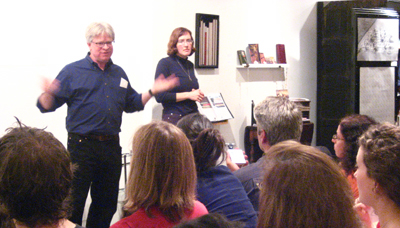 The year-long Interdisciplinary Library Exhibit started last night at Proteus Gowanus, an arts organization located in Brooklyn, New York. The opening event was a standing room only presentation by Rick Prelinger and Megan Shaw Prelinger who run the Prelinger Library. Their presentation focused on their work leading up to the creation of the library, a highly curated collection of printed matter they have accumulated over two decades. The collection has a strong focus on books, print ephemera and periodicals. The 40,000 plus items are now on display and open to the public in downtown San Francisco. Visitors are allowed to stop in and browse items from the collection. The library’s collection is an amazing experiment in curation, taxonomy (they created their own,) and commentary on how libraries are shifting forms. We were fortunate to have lunch with Rick and Megan before their event. Everyone at the institute found their work very inspiring and they will be discussed in more detail in upcoming posts.
The year-long Interdisciplinary Library Exhibit started last night at Proteus Gowanus, an arts organization located in Brooklyn, New York. The opening event was a standing room only presentation by Rick Prelinger and Megan Shaw Prelinger who run the Prelinger Library. Their presentation focused on their work leading up to the creation of the library, a highly curated collection of printed matter they have accumulated over two decades. The collection has a strong focus on books, print ephemera and periodicals. The 40,000 plus items are now on display and open to the public in downtown San Francisco. Visitors are allowed to stop in and browse items from the collection. The library’s collection is an amazing experiment in curation, taxonomy (they created their own,) and commentary on how libraries are shifting forms. We were fortunate to have lunch with Rick and Megan before their event. Everyone at the institute found their work very inspiring and they will be discussed in more detail in upcoming posts.
The spirit of the Prelinger’s work is great introduction to Proteus Gowanus’ exploration on this theme. Libraries are in flux, as they have historically played many roles, including distributors of knowledge, places that support research, archives and now quite often, community centers. For the next year, Proteus Gowans is displaying in their gallery, artwork related to libraries as well as hosting presentations and films. Photos by Nina Katchadourian depict the spines of various books which compose textual messages. Artist Jeffrey Schiff’s contribution plays with the Dewey Decimal System and themes of categorizations by applying call numbers to everyday objects and spaces. Also, included in the exhibit is the Reanimation Library, curated and owned by Andrew Beccone. This collection preserves books that are not typically saved in public and academic libraries, including titles such as “Simplified Taxidermy,” “A Guide to Gymnastics” and “Judo: Thirty Lessons in the Modern Science of Jiu-Jitsu.” The next event is Deirdre Lawrence, the Principal Librarian and Coordinator of Research Services Museum Libraries and Archives at the Brooklyn Museum, on October 27th.
Issues of funding, the rise of the digital, and intellectual property are all changing the role of libraries and how people interact with them. Many large questions are being asked about the future of the library. The most basic one being, what will it look like? Will it start to shift towards smaller nodes of semi-private collections connected to each other via the network? Are collections of books going to be increasingly less tied to physical spaces? Will the public library continue to shift towards acting more like a community center? Are publishers and libraries going fuse and produce a new hybrid institution?
Realizing that libraries are going through a cultural as well as technological transformation, Proteus Gowanus is embarking on an year long examination in a variety of media which track these changes. They may not be able to answer any of these questions directly, but they are certainly providing new directions and understandings. Most importantly, the Interdisciplinary Library Exhibit is opening up the conversation to a diversity of voices, including the public at large.
dexter sinister and just in time publishing
 Deep in Manhattan where the lines between Chinatown and the Lower East Side blur, the basement of a non-descript building houses a graphic design firm / publishing house / bookstore. The entrance is easy to miss, with a small spray-painted trumpet, taken from Thomas Pynchon’s The Crying Lot of 49, marking a handrail. However on Saturdays, hinged metal basement doors are left open, signaling that “Dexter Sinister: Just-In-Time Workshop & Occasional Bookstore” is open.
Deep in Manhattan where the lines between Chinatown and the Lower East Side blur, the basement of a non-descript building houses a graphic design firm / publishing house / bookstore. The entrance is easy to miss, with a small spray-painted trumpet, taken from Thomas Pynchon’s The Crying Lot of 49, marking a handrail. However on Saturdays, hinged metal basement doors are left open, signaling that “Dexter Sinister: Just-In-Time Workshop & Occasional Bookstore” is open.
Dexter Sinister is the moniker that designers David Reinfurt and Stuart Bailey adopted last spring to describe the various forms their work takes. I’ve known David for a number of years, but haven’t talked to him in a while. A few Saturdays ago I stopped by Dexter Sinister catch up with him to see “Just in Time Workshop” in action.
Before stopping by, I checked out their website, and saw that they are playing with and pushing against traditions of publishing in some interesting ways.
From their site:
“In the basement at 38 Ludlow Street we will set up a fully-functioning Just-In-Time workshop, against waste and challenging the current state of over-production driven by the conflicting combination of print economies-of-scale (it only makes financial sense to produce large quantities) and the contained audiences of art world marketing (no profit is really expected, and not many copies really need to be made.) These divergent criteria are too often manifested in endless boxes of unsaleable stock taking up space which needs to be further financed by galleries, distributors, bookstores, etc. This over-production then triggers a need to overcompensate with the next, and so on and so on. Instead, all our various production and distribution activities will be collapsed into the basement, which will double as a bookstore, as well as a venue for intermittent film screenings, performance and other events.”
The Occasional bookstore sells copies of works of their own, their colleagues, and work put out from other small presses. The inventory consists of a handful of these titles at a time, which can fit on one shelf in the corner, in my estimation without irony. In fact, the bookstore’s size precisely fits the overall Dexter Sinister ethos.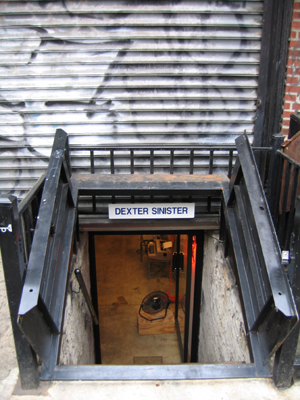
Further back, I saw a mimeograph, an Apple Image Write printer and an IBM electric typewriter that were all lined up in a row. David noted that he does not overly romanticize the mechanical age of print technology with these similarly monochromatic tan-brown machines. This is, his interest is not in retro for retro’s own sake. Rather, when printer technology was mostly mechanical (rather than computerized,) designers and publishers could tinker, fix and modify their equipment. Car enthusiasts have noted a similar loss, as automobiles have become increasingly computerized as well.
Dexter Sinister produce their books in small runs that are meant to sell out. Further, their publications tend to be highly selective, limited, and personal. However, they aren’t gatekeepers. Instead, the overall impression is that they are interested in supportive projects that matter to them. For instance, Dexter Sinister now produces “dot dot dot,” the design periodical that Stuart co-edited and designed while living in the Netherlands. When the print runs do sell out, they can issue re-prints in any number of printing options depending upon the circumstance, if they want to, or not.
 Some of their publications are printed on their mimeograph. While being well designed, the printing is fast and inexpensive, but avoids feeling overly cheap. Although, the final result reminds me of the pirated textbooks I encountered in China in the mid 90s. Inexpensive doesn’t necessarily mean boring and poor quality. Rather, it provides another design constraint under which to find new solutions. They’re also experimenting with lulul.com and have done born-digital projects as well.
Some of their publications are printed on their mimeograph. While being well designed, the printing is fast and inexpensive, but avoids feeling overly cheap. Although, the final result reminds me of the pirated textbooks I encountered in China in the mid 90s. Inexpensive doesn’t necessarily mean boring and poor quality. Rather, it provides another design constraint under which to find new solutions. They’re also experimenting with lulul.com and have done born-digital projects as well.
What’s really interesting to me is that DS and the institute share many ideas in common. However the execution of these ideas and solutions are entirely different. Although, the institute’s foci are often pointed at the digital, we certainly support the future of print (despite the fact that we get asked to comment or qualify the position of “death of print” quite often.) Distribution of digital media via the network is one vector. Small run, niche, highly curated, print publishing is another. In both cases, we have run into the failures of the current economic models of many traditional kinds of publishing. I’m reminded of the analogy of water, flowing down a mountain, seeking a path of minimal resistance. Similarly, information “wants” to intrinsically find its expression by the easiest pathways.
Later in a follow-up email exchange, we were talking about these various new modes of publishing. David noted that, “it feels like some particular in-between moment, just in general, with an overall apocalyptic vibe. It’s definitely the end of something and I suppose the beginning of something else.” Exactly.
documentary licensed through creative commons to play in second life
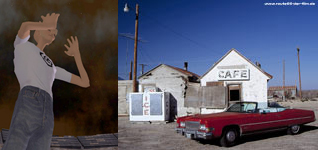
Route 66: An American Bad Dream is an independent documentary film starring three Germans road tripping across the legendary US highway. What makes this film notable is that they released the film under the Creative commons license. Also, it had its premiere in the virtual world of Second Life on Aug 10th. The success of that showing prompted them to host an additional viewing this Thursday August 31 at 4PM SL in Kula 4, which will be presented by its creator Gonzo Oxberger. In the Open Source spirit of this project, they are making the video and audio project files available to anyone with a serious interest in remixing the film.
the wisdom of fortune cookies: “your reputation is your wealth”
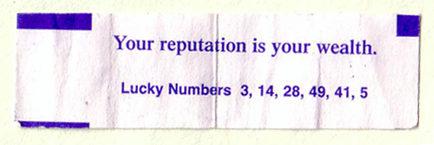
Over cold jasmine tea and quartered oranges in Chinatown, I got this little gem of a fortune. I chuckled at its relevance to our work at the institute. With the rise of self publishing (blogs, wikis, and POD), being google searchable, and content being freely given away, I wonder what our readers think about reputations being our wealth. Is this truth, nothing new, tom foolery, or just a fad? Has the concept of “reputation” changed? Have you and your work felt an effect as well? If so, how? I’m looking forward to hearing your thoughts.
“highbrow” video games?
 Recently in the gaming blog Gamersutra, Ernest Adams questions why aren’t there highbrow video games.” His article comes one month after an Esquire article, where Chuck Klosterman wondered why isn’t there good video game criticism and makes the claim that video games needs its own Lester Bangs. As the video game market grows, it is not surprising that fans and advocates of gaming will want to form to grow and mature as well.
Recently in the gaming blog Gamersutra, Ernest Adams questions why aren’t there highbrow video games.” His article comes one month after an Esquire article, where Chuck Klosterman wondered why isn’t there good video game criticism and makes the claim that video games needs its own Lester Bangs. As the video game market grows, it is not surprising that fans and advocates of gaming will want to form to grow and mature as well.
Adams’ call for “highbrow” games is rooted in a desire to add creditability and legitimacy to video games. As someone who has dedicated his career to making and writing about video games, the never-ending criticism about the violence in games by various groups looking for easy political targets must be frustrating to endure. I can appreciate the motivations behind Adam’s conclusion, however, his description of highbrow video games is ultimately too narrowly defined and overlooks impressive experiments of video games.
I hesitate to even try to deem games “high” or “low” because the terms are not that useful. Adams specifically points out that the films he aspires video games to emulate are not “art films,” which he describes as a “short low-budget titles filled with impenetrable weirdness.” Therefore, his definition of highbrow edge towards the problematic “I know it when I see it” definitions of art. Further, we can gather insight on culture and ourselves by interacting will both high and low culture and valuing one form over another is problematic.
From his description of a highbrow video game, I think what Adams is really asking for is better interactive narratives in gaming. He alludes to the films of Ishmail Merchant and James Ivory, who are best known for adopting the novels of E.M. Forester, often with screenwriter Ruth Prawer Jhabvala. Their films tend to be beautiful, well crafted analyses of class. Although, they are not generally know for pushing the boundaries of film.
Last year, Adams gave a talk which he published on his website, in which he assesses the state of interactive narrative. It provides more insight on his train of thought. In it, one of his references in video game scholarship is Janet Murray’s Hamlet on the Holodeck which uses a theatrical frame of reference in postulating the future of interactive narrative. Also, Adams offers a model of a “structured” approach to the narrative of video games and reveals that he is particularly wedded to the idea of single player games over the shared gaming experience of MMORPGs which are increasingly popular. In his current essay, his description of states that the highbrow video game “would reward close attention and playing more than once.” This implies that he still leans towards single player role playing games in his conceptualization of highbrow games.
However, video games that are pushing the form in more “artistic” ways are occurring outside the bounds of single player game. For example, we-make-money-not-art reported on The Endless Forest, which is a gorgeous MMORPG in which players assume the identity of a deer. Developed by the Belgian studio Tale of Tales, The Endless Forest has an elegant interface and darkly rich art direction. Although it lacks an explicit narrative, the gameplay engages users without the typical violence and sexually charged themes of many games. The Endless Forest limits the use of language. Therefore, it does not include a chat function and players are “named” with pictograms rather than words. However, as more of these kinds of games are created, they are unlikely to lessen the criticism of the negative social effects of video games.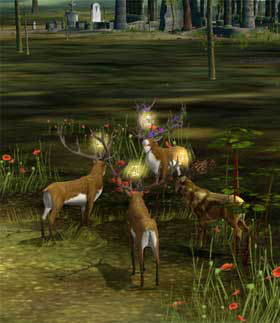
As for criticism, the notion of elevating video game criticism to a higher form is rather ironic, as it comes at the same time when the New York Times critic A.O. Scott finds himself defending film criticism. While not a music critic, Scott describes the critics’ predicament that often panned movies are still hugh box offices successes. Media critics want the new and interesting, which is somewhat expected if it is your job to watch and write about movies, music, or video games everyday. Their standards are quite different from the typical audience member. Lester Bangs was a polarizing figure, who wanted to raise the standards of writing on music. He appeared at a time when people were ready for similar standards. It may be that a critical mass of audience for a similar kind of criticism for gaming is beginning to emerge.
As previously stated, most gamers will still want “mainstream” titles. Because games are expensive, they will still rely on criticism which Klosterman dismissives as “customer advice.” That is, many gamers, if not most, will still mostly be interested in reading reviews which describe gameplay, graphics and sound design, rather than thematic and issues of meaning. Many gamers don’t like the academic scholarly writing on video games, which is in adbundance, but is not what Klosterman wants to read. We learned about their attitutdes in initial reactions and comments posted across the gaming blogosphere about our project “GAM3R 7H30RY.” It’s not clear to me what is bad about gaming publications serving the desires of the video game playing community.
 My guess is that both boundary pushing video games and criticism will be begin to get more exposure fairly soon. For the actual video games, I would look towards Europe and Asia, where more government funding exists for developing these kinds of endeavors. I don’t expect many of the big gaming companies in the US to create experimental games of this nature. Although, they might in the future, after the proven economic viability of them. In that, major movie studios started funding more smaller films after they saw successful crossover of films of the Merchant Ivory variety. Although, Rockstar (the maker of Grand Theft Auto) have the upcoming and already controversial game Bully, where you must navigate a boarding school as a new student. It was described by the New York TImes as having, “an open world for the players to explore, tightly defined and memorable characters, a strong story line, [and] high-end voice acting,” which is precisely what Adams call for in his article.
My guess is that both boundary pushing video games and criticism will be begin to get more exposure fairly soon. For the actual video games, I would look towards Europe and Asia, where more government funding exists for developing these kinds of endeavors. I don’t expect many of the big gaming companies in the US to create experimental games of this nature. Although, they might in the future, after the proven economic viability of them. In that, major movie studios started funding more smaller films after they saw successful crossover of films of the Merchant Ivory variety. Although, Rockstar (the maker of Grand Theft Auto) have the upcoming and already controversial game Bully, where you must navigate a boarding school as a new student. It was described by the New York TImes as having, “an open world for the players to explore, tightly defined and memorable characters, a strong story line, [and] high-end voice acting,” which is precisely what Adams call for in his article.
Regardless of who moves video games and its coverage further, it’s bound to happen. Although, these new forms may not look exactly has Adams and Klosterman describe or wish. Media takes time to evolve, just compare the “highbrow” television series the HBO produces as compared to rather “lowbrow” television from the 50s. (I will admit that I don’t prefer one over the other.) For a great example of how a medium transforms the perspective of an artist, see Scott McCloud’s description of the movement from comic book fan to student to professional to genre pushing pioneer in Understanding Comics. If someone really wants to write video game criticism in the style of Lester Bangs, then the current low barriers of entry to electronic self-publishing allows her to do so. Creating video games, of course, requires a lot more resources. However, in closing, Adams states, “maybe I’ll design one myself, just for the fun of it.”
call for papers: what to do with a million books
The Humanities Division at the University of Chicago and the College of Science and Letters at the Illinois Institute of Technology are hosting an intriguing colloquium on the future of research in the humanities in response to the rapid growth of digital archives. They are currently accepting paper proposals, which are due at the end of August.
Here is the call for papers:
What to Do with a Million Books: Chicago Colloquium on Digital Humanities and Computer Science
Sponsored by the Humanities Division at the University of Chicago and the College of Science and Letters at the Illinois Institute of Technology.
Chicago, November 5th & 6th, 2006
Submission Deadline: August 31st, 2006
The goal of this colloquium is to bring together researchers and scholars in the Humanities and Computer Sciences to examine the current state of Digital Humanities as a field of intellectual inquiry and to identify and explore new directions and perspectives for future research.
In the wake of recent large-scale digitization projects aimed at providing universal access to the world’s vast textual repositories, humanities scholars, librarians and computer scientists find themselves newly challenged to make such resources functional and meaningful.
As Gregory Crane recently pointed out (1), digital access to “a million books” confronts us with the need to provide viable solutions to a range of difficult problems: analog to digital conversion, machine translation, information retrieval and data mining, to name a few. Moreover, mass digitization leads not just to problems of scale: new goals can also be envisioned, for example, catalyzing the development of new computational tools for context-sensitive analysis. If we are to build systems to interrogate usefully massive text collections for meaning, we will need to draw not only on the technical expertise of computer scientists but also learn from the traditions of self-reflective, inter-disciplinary inquiry practiced by humanist scholars.
The book as the locus of much of our knowledge has long been at the center of discussions in digital humanities. But as mass digitization efforts accelerate a change in focus from a print-culture to a networked, digital-culture, it will become necessary to pay more attention to how the notion of a text itself is being re-constituted. We are increasingly able to interact with texts in novel ways, as linguistic, visual, and statistical processing provide us with new modes of reading, representation, and understanding. This shift makes evident the necessity for humanities scholars to enter into a dialogue with librarians and computer scientists to understand the new language of open standards, search queries, visualization and social networks.
Digitizing “a million books” thus poses far more than just technical challenges. Tomorrow, a million scholars will have to re-evaluate their notions of archive, textuality and materiality in the wake of these developments. How will humanities scholars, librarians and computer scientists find ways to collaborate in the “Age of Google?”
(1) http://www.dlib.org/dlib/march06/crane/03crane.html
Colloquium Website
http://dhcs.uchicago.edu/announcement/
Date
November 5th & 6th, 2006
Location
The University of Chicago
Ida Noyes Hall
1212 East 59th Street
Chicago, IL 60637
Keynote Speakers
Greg Crane (Professor of Classics, Tufts University) has been engaged since 1985 in planning and development of the Perseus Project, which he directs as the Editor-in-Chief. Besides supervising the Perseus Project as a whole, he has been primarily responsible for the development of the morphological analysis system which provides many of the links within the Perseus database.
Ben Shneiderman is Professor in the Department of Computer Science, founding Director (1983-2000) of the Human-Computer Interaction Laboratory, and Member of the Institute for Advanced Computer Studies and the Institute for Systems Research, all at the University of Maryland. He is a leading expert in human-computer interaction and information visualization and has published extensively in these and related fields.
John Unsworth is Dean of the Graduate School of Library and Information Science and Professor of English at the University of Illinois at Urbana-Champaign. Prior to that, he was on the faculty at the University of Virginia where he also led the Institute for Advanced Technology in the Humanities. He has published widely in the field of Digital Humanities and was the recipient last year of the Lyman Award for scholarship in technology and humanities.
Program Committee
Prof. Helma Dik, Department of Classics, University of Chicago
Dr. Catherine Mardikes, Bibliographer for Classics, the Ancient Near East, and General Humanities, University of Chicago
Prof. Martin Mueller, Department of English and Classics, Northwestern University
Dr. Mark Olsen, Associate Director, The ARTFL Project, University of Chicago
Prof. Shlomo Argamon, Computer Science Department, Illinois Institute of Technology
Prof. Wai Gen Yee, Computer Science Department, Illinois Institute of Technology
Call for Participation
Participation in the colloquium is open to all. We welcome submissions for:
1. Paper presentations (20 minute maximum)
2. Poster sessions
3. Software demonstrations
Suggested submission topics
* Representing text genealogies and variance
* Automatic extraction and analysis of natural language style elements
* Visualization of large corpus search results
* The materiality of the digital text
* Interpreting symbols: textual exegesis and game playing
* Mashup: APIs for integrating discrete information resources
* Intelligent Documents
* Community based tagging / folksonomies
* Massively scalable text search and summaries
* Distributed editing & annotation tools
* Polyglot Machines: Computerized translation
* Seeing not reading: visual representations of literary texts
* Schemas for scholars: field and period specific ontologies for the humanities
* Context sensitive text search
* Towards a digital hermeneutics: data mining and pattern finding
Submission Format
Please submit a (2 page maximum) abstract in either PDF or MS Word format to dhcs-submissions@listhost.uchicago.edu.
Important Dates
Deadline for Submissions: August 31st
Notification of Acceptance: September 15th
Full Program Announcement: September 15th
Contact Info
General Inquiries: dhcs-conference@listhost.uchicago.edu
Organizational Committee
Mark Olsen, mark@gide.uchicago.edu, Associate Director, ARTFL Project, University of Chicago.
Catherine Mardikes, mardikes@uchicago.edu, Bibliographer for Classics, the Ancient Near East, and General Humanities, University of Chicago.
Arno Bosse, abosse@uchicago.edu, Director of Technology, Humanities Division, University of Chicago.
Shlomo Argamon, argamon@iit.edu, Department of Computer Science, Illinois Institute of Technology.
kairos turns ten
Last week marked the release of the ten year anniversary issue of Kairos, the online refereed journal of rhetoric, technology and pedagogy. The anniversary issue looks both back and forward. This milestone is notable because ten web years feels like dog years. Just consider the state of the web in 1996, where amazon.com was one year old, altavista was the leading search engine, Flash 1 got its release, and javascript was the cutting edge in web programming. Started by graduate students, Kairos has always focused on webtexts which explored the new potentials of the web as a medium, rather than simply uploading the static text of a print journal.
The issue contains interviews with people reflecting upon their experiences with rhetoric/ composition and digital technology and Kairos. As well, Jim Kalmbach gives a good overview of the scholarship which took place within Kairos over the past ten years. He concludes with this following statement:
“…we do not need ever more stunning hypermediated essays; we need new forms of scholarship; we need to think about new ways of using digital writing spaces to make meaning.”
His statement is a good transition to a new section in Kairos called Inventio, which will publicly track an article through the editorial process from inception to publication. As described, this section will:
(a) to provide a publication venue for experimental scholarly texts that push technological boundaries, and (b) to make Kairos’ editorial and peer-review decisions for innovative scholarly webtexts more explicit.
I’m looking forward to seeing the first article from this section to appear in the fall of next year. It is another project along the same lines as our project, MediaCommons. People from many directions are clearly realizing the potential in pursuing more ways to develop and share academic scholarship. I excited to see that it is starting to occur on many fronts, and I am happy that the institute, as well as, this pioneering journal are part of it.
shifting forms of graffiti
A few weekends ago, I was returning into Manhattan from upstate New York. Coming down the FRD along the East River, we past Keith Haring’s “Crack is Wack” mural on 128th and 2nd. I remember the first time I saw it in the 80s on a family day trip into the city. The work is strikes me as quite extraordinary, even 20 years after its creation in 1986. By that time, Haring was established in the art world, having already shown at the Venice Biennale and the Whitney Biennial and had solo shows at the Tony Shafrazi Gallery and the Leo Castelli Gallery. Even though Haring was part of that contemporary/ high brow art world, he still maintained a connection to his roots of skirting the lines between public street art and illegal graffiti. “Crack is Wack” mixed of graffiti street culture, political and social messages, and high art. Although, the mural was quickly placed under the protection and jurisdiction of the City Department of Parks.
Haring took cues from graffiti, among other sources of influence, and created his own style and form. Revisiting “Crack is Wack” got me thinking about graffiti and how it has evolved of the past few decades. The funny thing about living in New York is that, after a while, you start seeing through the visual chaos of our surroundings. When you take a moment to stop and look, it is amazing what you can actually see. The things that you walk by everyday, especially stand out.
Graffiti, which had faded into the background visual noise of New York, was back on my radar screen. It was, of course, everywhere, but it had also changed since I really paid attention to it. Ben posted about a show on graffiti at the Brooklyn Museum, and that was just one aspect of how graffiti has expanded beyond the traditional notions of the form. At the institute, we spend a lot of time thinking about the evolution of media, and it seems that graffiti is no different.
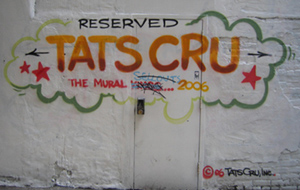 On a side street near Little Italy, there used to be an advertisement for the Sony PSP done by the graffiti artists Tat’s Cru. Now, the brick space has a place holder of an advertisement for these graffiti artists for hire. An interesting comment was left by a rival tagger, saying “sell out.” And then someone else left their tag over the unsolicited commentary. I love the on-going asynchronous dialogue occurring on this brick wall of this corner deli. It is not surprising that others would be upset at Tat’s Cru getting paid by advertisers for marketing. The website shows a piece that they did for BP. Working for the oil industry certainly will raise doubts to the authenticity and street credibility by purists of the form.
On a side street near Little Italy, there used to be an advertisement for the Sony PSP done by the graffiti artists Tat’s Cru. Now, the brick space has a place holder of an advertisement for these graffiti artists for hire. An interesting comment was left by a rival tagger, saying “sell out.” And then someone else left their tag over the unsolicited commentary. I love the on-going asynchronous dialogue occurring on this brick wall of this corner deli. It is not surprising that others would be upset at Tat’s Cru getting paid by advertisers for marketing. The website shows a piece that they did for BP. Working for the oil industry certainly will raise doubts to the authenticity and street credibility by purists of the form.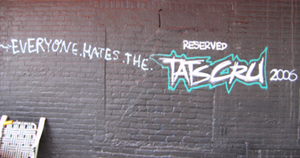
Perhaps, the work of the Tats Cru has not branched off to the new genre of graffiti but circled back to another form. Take this painted billboard for the debut solo record by Radiohead frontman Thom Yorke. The billboard appeared in Williamsburg in the weeks leading up to its release. Within moments, my initial thought that it was some hard core fan’s ode to British rock was replaced with the realization that this was paid for by a record label.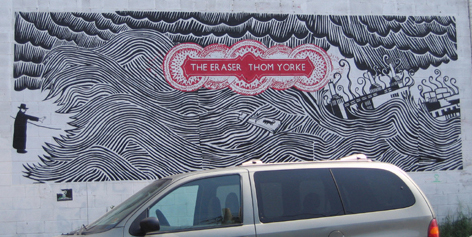
Referencing graffiti in advertising is nothing new. Turning actual graffiti into the advertising was the obvious next step. If graffiti is paid for and created for marketing purposes, at what point does it stop being graffiti? Has it turned into something else? Is it just a style of art using spray paint to create forms referencing hip-hop?
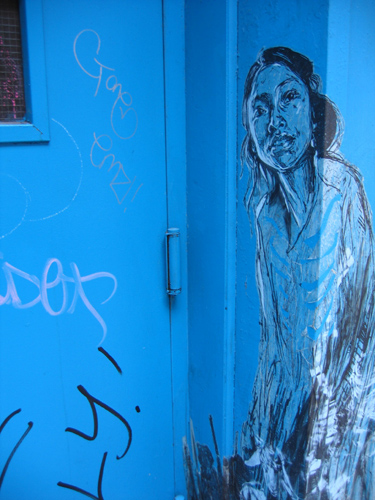 Sometime after seeing Haring work, I passed this stoop a few blocks north of Chinatown. There was another similar work by the same artist I saw in the Lower East Side, however, I couldn’t find it again.
Sometime after seeing Haring work, I passed this stoop a few blocks north of Chinatown. There was another similar work by the same artist I saw in the Lower East Side, however, I couldn’t find it again.
But the work kept on reappearing. And then, I noticed another one a few blocks from the institute’s office in Brooklyn. I probably walked past it hundreds of times before stopping to notice it. You can see where someone tried to tear it off, because in fact, the figures are not drawn on the wall, but on paper. The image is then transferred to the wall. Is this cheating? Suddenly, form and material are being challenged.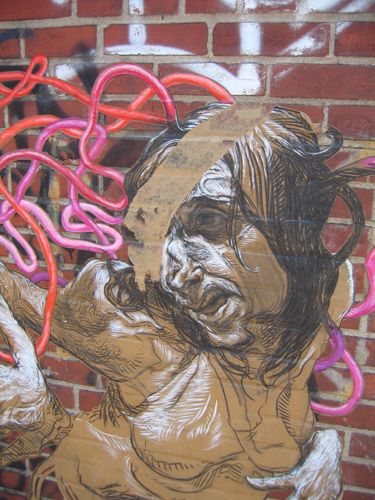
I did stumble upon Ping Magazine, when a friend sent me another article from the site. I finally learned that these pieces were created by an artist who goes by Swoon. She gave an interview for the New York Times, and describes herself as street artist, but considers her work graffiti. More importantly, she does not talk about the legal nature or the materiality of her work, but focuses on its location in public spaces and its direction interaction with people.
Keith Haring ended up being a great starting point, because of his work is a hybrid many forms and influences, including graffiti but also things beyond it. His mural reminded me that graffiti has embodied a range of politics, material and cultures for decades. Forms of expression emerge, branch off and circle back. Subsequent generations focus on different areas, be it monetary or expressive. Today, art and advertising are often re-appropriations of each other, as forms blend into one another. Empty spaces are filled with media by both artists and advertisers. The arts organization the Wooster Collective shows how broadly the concept of street art can extended. Trying to restrict these forms to bounded definitions is marginally useful, and often futile.
In this investigation, I was surprised at what I found, and amused at how often I circled back to the question of what is graffiti? The question or process of re-seeing something itself is not that surprising, particularly in the context of our work at the institute. Although, we focus more time on textual media, many of the questions remain the same. As we witness the evolving forms of text and the book, we can learn from other forms that turn into something slightly familiar but also remarkably new.
clifford lynch takes on computation and open access
Academic Commons mentions that Clifford Lynch has written a chapter, entitled, “Open Computation: Beyond Human-Reader-Centric Views of Scholarly Literatures” in an upcoming book on open access edited by Neil Jacobs of the Joint Information Committee. His chapter, which is available online, looks at the potential computational analyses that could be formed by collecting scholarly literature into a digital repository. These “large scholarly literature corpora” would be openly accessible and used for new branches of research currently not possible.
He takes cues from the current work in text mining and large scale collections of scholarly documents, such as the Persus Digital Library hosted by Tufts Unviersity. Lynch also acknowledges the skepticism that many scholars hold to the value of text mining analysis in the humanities. Further, he discusses the limitations that current intellectual property regimes place on the creation of a large, accessible scholarly corpora. Although many legal and technical obstacles exist, his proposal does seem more feasible than something like Ted Nelson’s Project Xanadu because the corpora he describes have boundaries, as well as supporters who believe that these bodies of literature should be accessible.
Small scale examples show the challenges Lynch’s proposal faces. I am reminded of the development of meta-analysis in the field of statistics. Although the term meta-analysis is much older, the contemporary usage refers to statistical techniques developed in the 1970s to aggregate results from a group of studies. These techniques are particularly popular in the medical research and the public health sciences (often because their data sets are small.) Thirty years on, these methods are frequently used and their resulted published. However, the methods are still questioned in certain circles.
Gene Glass gives a good overview of meta-analysis, concluding with a reflection on how the criticisms of its use reveal insights on fundamental problems with research in his field of education research. He notes the difference in the “fundamental unit” of his research, which is a study, versus physics, which is lower level, accessible and generalizable. Here, even taking a small step back reveals new insights on the fundamentals of his scholarship.
Lynch speculates on how the creation of corpora might play out, but he doesn’t dwell on the macro questions that we might investigate. Perhaps it is premature to think about these ideas, but the possible directions of inquiry are what lingered in my mind after reading Lynch’s chapter.
I am struck by the challenge of graphically representing the analysis of these corpora. Like the visualizations of the blogosphere, these technologies could not only analyze the network of citations, but also word choice and textual correlations. Moreover, how does the body of literature change over time and space, as ideas and thoughts emerge or fall out of favor. In the humanities, can we graphically represent theoretical shifts from structuralist to post-structuralist thought, or the evolution from pre-feminist to feminist to post-feminist thought? What effect did each of these movements have on each other over time?
The opportunity also exists of exploring the possible ways of navigating corpora of this size. Using the metaphor of Google Earth, where one can zoom in from the entire Earth down to a single home, what can we gain from being able to view the sphere of scholarly literature in such a way? Glass took one step back to analyze groups of studies, and found insight on the nature of education research. What are the potential insights can we learn from viewing the entire corpus of scholarly knowledge from above?
Lynch describes expanding our analysis beyond the human scale. Even if his proposal never reaches fruition, his thought experiments revealed (at least to me) how knowledge acquisition occurs over a multidimensional spectrum. You can have a close reading of a text or merely skim the first sentence of each paragraph. Likewise, you can read an encyclopedia entry on a field of study or spend a year reading 200 books to prepare for a doctoral qualifying exam. However, as people, we have limits to the amount of information we can comprehend and analyze.
Purists will undoubtedly frown upon the use of computation that cannot be replicated by humans in scholarly research. Another example is the use of computational for solving proofs in mathematics, which is still controversial. The humanities will be no different, if not more so. A close reading of certain texts will always be important, however the future that Lynch offers just may give that close reading an entirely new context and understanding. One of the great things about inquiry is that sometimes you do not know where you will end up until you get there.
